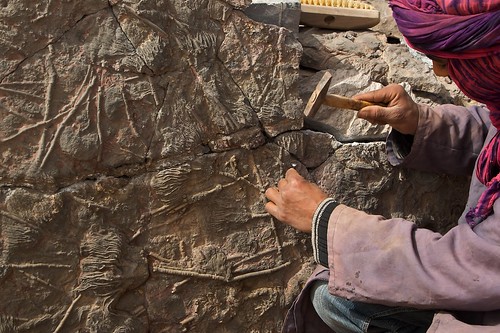Palaeontology is one of the rare areas of science that teenagers can tackle by themselves, especially if they live in a fossil-rich area. All that is needed is a hammer and passion. Such an early training certainly helps the happy few who finally manage to become professionals, as was the case for Richard Fortey. I empathize with him, as I too had a youthful passion for fossils.
In this book, Fortey gives a passionate and often lyrical account of his life with trilobites, a group of extinct marine arthropods related to the living horseshoe crabs and spiders, which lived from 540 to 260 million years ago. Trilobites are indeed fascinating. They look a bit like large woodlice, but show an amazing diversity of morphologies. What's more, their preserved anatomy is complex enough to allow scientists to reconstruct the group's relationships and evolutionary history.
In a vivid, popular style, full of didactic metaphors and anecdotes, Fortey writes about how his passion for trilobites arose when he was 14, how he was trained by his mentor Harry Whittington, how he discovered new trilobites in the rocks of Spitsbergen, China, Thailand and Australia, and his life with colleagues in the small community of trilobite specialists. He also recounts the history of trilobite research, how early palaeontologists gradually revealed the most intimate details of trilobite anatomy: the amazing structure of their eyes, and their long-elusive appendages and gills. Fortey uses trilobites to explain how palaeontologists work, from basic fieldwork and identifying and describing species to far-reaching generalizations about evolution. Seen in this way, the book is an excellent introduction to the basic practice of palaeontology and systematics.
Trilobites have been in at the birth of several theories about the process of evolution. For example, there is Niles Eldredge and Stephen Jay Gould's 'punctuated equilibria', an evolutionary pattern where a species shows a long period of stability (equilibrium) and is then suddenly replaced by its closest related species (punctuation). Or there is McNamara's 'heterochronism', an evolutionary process involving shifts in the timing of the development of certain organs, and hence shifts in the morphology of the entire organism. Trilobites are also there at the Cambrian explosion -- the period 540 million years ago where most major animal groups appear suddenly in the fossil record. Fortey uses trilobite examples to explain and discuss these palaeontological classics.
Here and there Fortey depicts the world of trilobite specialists, past and present, and recounts his field adventures in a 'Tintin-and-the-lost-trilobite' style. Those who know the field or palaeontologists may, however, dislike the way he uses examples of how rude and sectarian some in this -- otherwise humble and idyllic -- community can be in settling scores with certain colleagues and journal editors.
Fortey's youthful enthusiasm is refreshing, but unfortunately this is often what managers of science dislike, as if enthusiasm and obsessive passion were a sin, a childish reaction of amateurs. Those who decide who will be selected for a life in science tend to prefer the cold-blooded ones, who have only scholarly experience filtered by the academic world. Yes, Fortey was very fortunate to be able to have such a straight career in trilobites, despite his passion. But some may say that his enthusiasm hinders him from taking a cold look at what trilobites can really tell us. He sees them swimming in the Ordovician sea, he imagines what they could see through the numerous calcite lenses of their eyes.
This book is pervaded by the idea that time is something very important, and unique, in palaeontological data. The author seems to be able to read evolution through the rock layers. He apparently expects something new and odd from his trilobites just because they are old, but at the same time he points out repeatedly how perfect they are in many respects, and their striking analogies to modern arthropods. To him, "palaeontology is a daughter of Old Time, or it is nothing", and time "tests the durability of scientific revelation".
Others see fossils as mere bearers of new characters or associations of characters, whose position in the tree of life sometimes reveals the pattern of relationships of other, distantly related living organisms. In this view, time is no longer a property of fossils, which are simply new organisms added to the diversity of life and ranked according to the logic of character distribution.
Trilobites are thrown clear of the Cambrian explosion and, as a figure caption says: "where are the ancestors of the trilobites?" Fortey admits the power of cladistics and character analysis in such cases, when time is mute and only characters speak. He also insists on the extraordinary diversity of the trilobites, which he portrays as a fanciful parade. But one would have expected some orderliness to emerge from this parade and for the genealogy of the group to be outlined.
As a whole, the book is a sprightly description of everyday life in palaeontology and of a small scientific community throughout time, with its great names (such as the French-born Joachim Barrande, to whom Bohemia was only a place of exile -- not a "home land"), its victims, tragedies, glories, awkward customers, (presumed) fraudsters, and many ordinary workers who accumulate data and new insights. Amateur palaeontologists, as well as professionals, who like nature's wonders and evolutionary scenarios will certainly love this book, and students will discover the kind of world they might step into.
Author Affiliation(s):
[1] Philippe Janvier is in the Laboratoire de Paléontologie,Muséum National d'Histoire Naturelle, 8 rue Buffon, 75005 Paris, France
DOI: 10.1038/35040646
Source Citation
Janvier, Philippe. "With a hammer and passion." Nature 408.6808 (2000): 27+. Academic OneFile. Web. 27 Dec. 2009.
Gale Document Number:A188067566



No comments:
Post a Comment